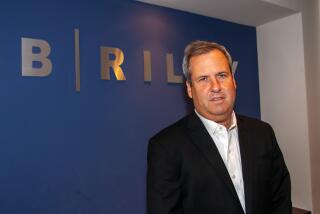SAN DIEGO COUNTY : Great American Bank Reports Loss of $10 Million, Reduced Dividend
- Share via
SAN DIEGO — Dogged by a deteriorating Arizona loan portfolio that shows little prospect of improving soon, Great American Bank on Wednesday reported a $10-million second-quarter loss and a reduction of its quarterly dividend by two-thirds, to 5 cents a share.
The loss, which contrasts with a $7.2-million second-quarter 1988 profit, was due in part to a $15.7-million non-cash charge resulting from a write-down of the capitalized value of Great American’s loan-servicing income. The write-down, which had been previously announced, came at the prodding of the Federal Home Loan Bank Board, which insisted that Great American state the current value of income flow more conservatively.
But the S&L;’s nemesis continues to be its Arizona loans inherited when it acquired Home Federal Savings of Tucson in 1986. Overbuilt commercial real estate markets in Tucson and Phoenix have caused severe problems with the portfolio, resulting in a continuing series of write-downs on the value of loans and repossessed property.
Arizona problems were largely responsible for Great American taking $38 million in provisions for probable loan and foreclosure losses in the quarter, up from $10.9 million in reserves set aside over the same quarter last year.
The loss provisions stunned stock analyst Joseph Jolson of Montgomery Securities in San Francisco, who said he was under the impression that Great American had “turned the corner” on its Arizona problems after reporting an $11-million first-quarter profit and taking only $3.5 million in provisions for loan and foreclosure losses.
“They’ve been telling us that the big losses have already been reserved for and now they come up with another $38 million (in reserves),” Jolson said. “This is sort of out of the blue.”
Jolson said that Great American’s decision to cut its quarterly dividend to 5 cents from 15 cents is “really a bad sign. The dividend was keeping the stock from dipping.” Great American stock, which closed down $.125 at $12.75 a share in Wednesday New York Stock Exchange trading, was unaffected by the earnings announcement, which was released after the stock market closed.
In an interview, Great American President Roger Lindland said the S&L;’s problems in Arizona stem from declining land values that have caused Great American to steadily write down its $120-million commercial land loan portfolio. Values have been hurt by a glut of available properties being sold by troubled banks and S&Ls; also stuck with bad loans.
“Whereas we thought we had pretty much turned the corner by the end of last year, the fact is there has been so much uncertainty (with the banks) there that it has caused people to sit on the sidelines and not invest in land,” Lindland said. The current market condition “won’t last forever, but it’s not something I see going away anytime soon.”
Despite the Arizona problems, Lindland predicted that Great American will be profitable the rest of 1989.
The main concern in Great American’s decision to cut its dividend, which will save it $2.4 million each quarter, is to preserve capital in light of expected provisions of the congressional S&L; bail-out bill, Lindland said.
One such provision in a current version of the legislation would force thrifts to maintain tangible net worth, or shareholder equity minus good will, at a minimum 3% of assets by 1994. Since Great American’s tangible net worth is now $415 million, or 2.6% of its $16.5 billion assets, the S&L; would need to raise its capital by either retaining earnings or reducing assets.
Great American’s second-quarter loss would have been more severe had it not reaped a $21.9-million gain from its real estate development activities, of which $18.5 million came from the sale of about 20% of the lots at its Redhawk residential development in Rancho California, Lindland said. Last year, the S&L;’s real estate profit for the quarter was $6.7 million.
For the quarter, Great American’s interest rate spread, or the difference between what it pays on deposits and other liabilities and what it collects on loans and other assets, was 1.75% of assets, down from the 1.92% spread a year ago, and 1.87% in first quarter of 1989, said chief financial officer Jim Krzeminski.
On the bright side, Great American’s interest income before loss provisions was $58.2 million, up from the $52.6 million in the second quarter last year. Loan originations totaled $1.24 billion, up from $990 million for the same three months in 1988. Almost 92% of the new loans featured variable interest rates tied to the S&L;’s cost of funds.
After taking more than $150 million in loan loss provisions over the last 18 months, Great American had whittled its non-performing assets down to $368 million, or 2.2% of assets, as of June 30, down from $511 million, or 3.3%, the previous year.
Great American reduced its general and administrative expenses during the quarter to 1.48% of assets, down from 1.52% during the first quarter, already among the lowest cost structures in the industry.
Assets of $16.5 billion as of June 30 were up from $15.4 billion a year previous. Lindland predicted that assets will remain flat through the rest of the year. Total loans were $11.7 billion, up from $10.1 billion a year ago, and deposits were $11.3 billion, up from $10.1 billion.
More to Read
Inside the business of entertainment
The Wide Shot brings you news, analysis and insights on everything from streaming wars to production — and what it all means for the future.
You may occasionally receive promotional content from the Los Angeles Times.










